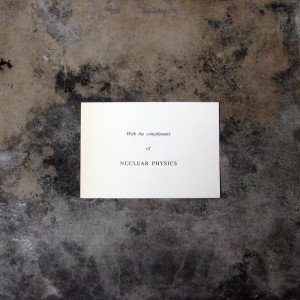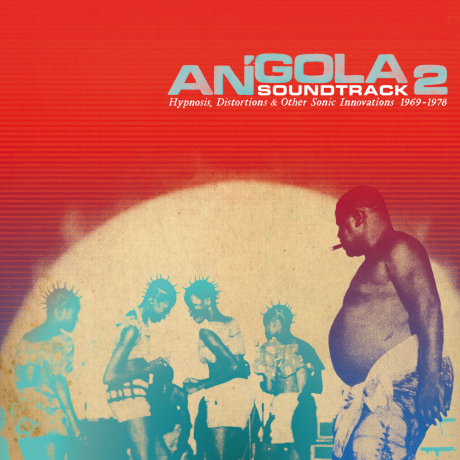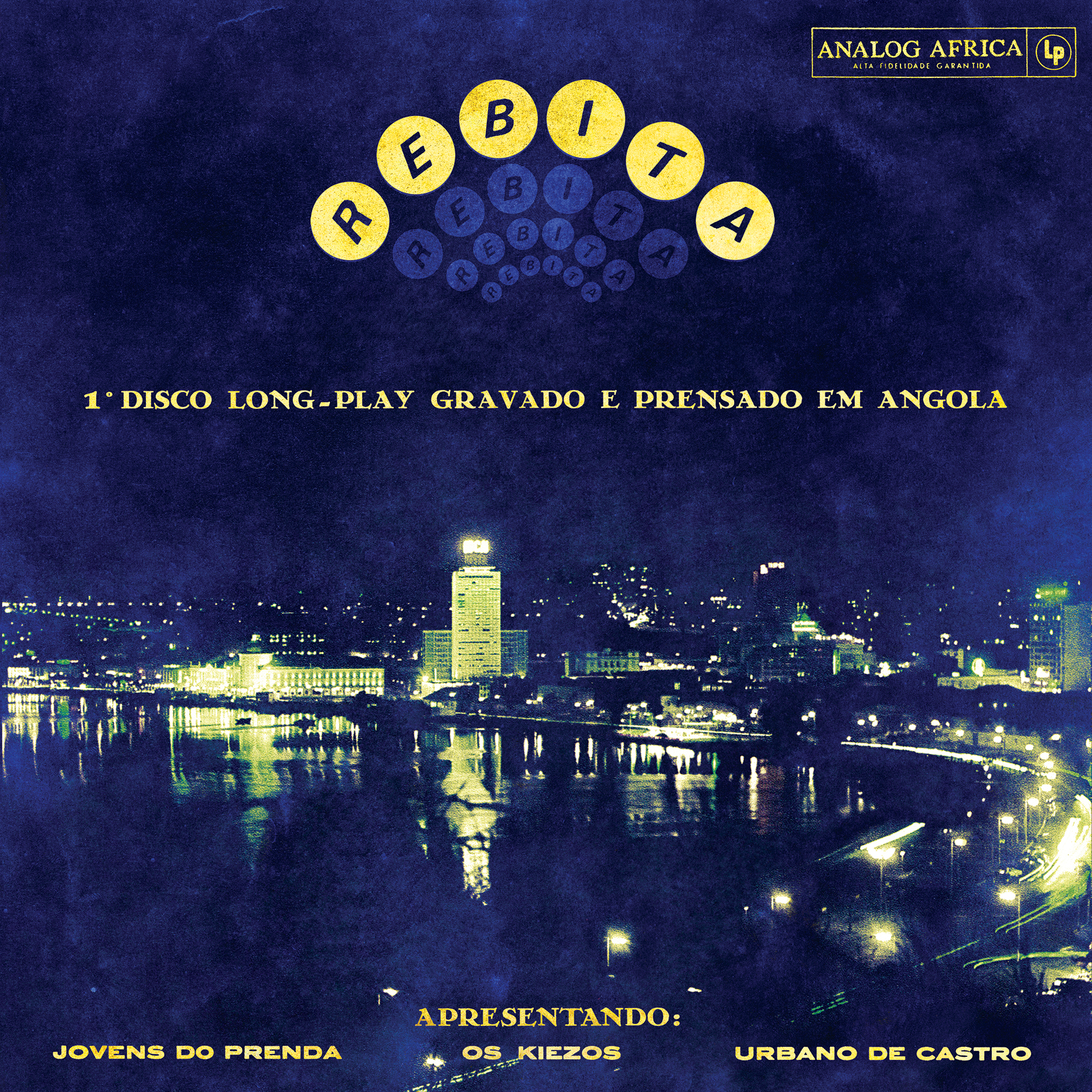GIITTV have kindly offered me a platform from which to share my pontifications, musings and observations. A humbled collaborator for the last few years to this very site, I’ve recently left my post to run my very own mouthpiece blog, Monolith Cocktail. Each week ‘Our Daily Bread’ (you’ll notice this is in fact a bum steer as it is only posted once a week rather than daily) features a polygenesis mix of world, krautrock, psych, bedroom music, folk, electronica and the obscure genres that have yet to be pigeonholed. From the latest and relatively unheard to the best or should I say more interesting reissues, the Monolith covers a wide array of music; collated from Byzantine to Ghana.
Here then is the first of what may be many ‘highlighted’ revues from the blog: including the upcoming Analog Africa label’s sauntering Angola Soundtrack 2, latest offering from ‘neo-krautrock’ devotees Eat Lights Become Lights and Can‘s ufo flight commanding helmsmen, Irmin Schmidt‘s tv/film soundtrack collection, Villa Wunderbar. Enjoy brothers and sisters, enjoy!
Eat Lights Become Lights ‘Dead Formats EP’ – Available via Bandcamp now
Back in September the Monolith gave the cosmic backpackers, Eat Lights Become Lights, Modular Living LP a joyful reception, describing them and their impressive long player thus:
‘A band of two halves so to speak, the recorded version almost totally helmed and written by the group’s Neil Rudd, and the live version which swells to a concomitant quartet (that greedily includes two drummers), follow the investigative footsteps of those that precede them; riffing and then locking down into the pulsing rhythm of an idealised Dusseldorf, Berlin and Cologne landscape of the early to late 70s. Though many thousands have trodden this pathway already, the Lights manage to navigate a subtler passage of veneration for the likes of Klaus Dinger, Michael Rothar and Roedelius; honing the halcyon dappled structures and beatific synth-textured symphonies of Cluster, Harmonia and Kraftwerk to produce something quite majestic.’
Vapourously drifting over glacier plains, the latest EP to drop from the self-proclaimed ‘neo-krautrock’ outfit, takes the trans-alpine express across a stirring, nee celestial, landscape. Split into two eponymous train rides of discovery, and a bonus track, entitled I believe after the Austrian town of Selesen, Dead Format pays homage to Cluster, Eno, Rothar and co. again.
‘Dead Format’ chimes, stirs and slowly surveys the lie of the land, building towards and opening out with a tightened Dinger style drum roll and flailing guitar noise. ‘Dead Format 2 (Live)’ is a more transcendent vibe, recalling the Tangerine Dream and palatial, church like soundtracks of Popol Vuh – a deft, haunting but ethereal piano is struck in the background as sighing synths gently caress an ambient melody.
Bonus, ‘Selesen 11’, is an expansive shivering tribal space vista that moves like liquid in its search beyond the summits of Earth.
Hardly a giant leap into the unknown or untethered from the ELBL moorings, this diaphanous, and unheralded, released on the sly, EP does take the group’s sound into more ambient territory; relying more upon synth textures and nuanced changes, and cutting back on the guitar and drums.
‘Angola Soundtrack 2 – Hypnosis, Distortions & Other Sonic Innovations 1969 – 1978’ (Analog Africa) – 2nd December 2013
Following the releases of both the Orchestre Poly-Rythmo de Contonou sampler and second volume of Ghanaian Afro-Beat, Afro-Beat Airways, earlier in the year, Samy Ben Redjeb’s Analog Africa label journeys south of the African equator once more to Angola: or to be more specific the capital port, and thriving center of the country’s nightlife, Luanda.
The former Portuguese colony had to wait until 1975 before gaining its independence, a year that not only sparked autonomy but a flourishing of the local music culture, which had been previously suppressed. However despite this suppression and the over-zealous banning in 1961 of carnival performances by the local street musicians (known as Turmans), Angola did have a fruitful recording industry: if sporadic one. With three companies producing 800 records, mostly singles, in a relatively short period between 1969-1978.
This 20-track (plus bonus track) compilation is a dedicated perusal through some of the most rare, hypnotic and addictive records to have been recorded during that golden era. Less funky and dynamic than their West African counterparts, yet perhaps more slinky and sauntering, the Angola music scene’s own familiar Kazukuta, Semba, Rebita styles were blended with influences from the Congo, Cape Verde and Dominican Republic, to create a Latin-flavoured percussive carnival groove.
Building on the award-winning inaugural compilation (which won the German Record Critics prize for best ‘black music’ album in 2010), volume 2 features another cast of stripped down reedy wah-wah bluesmen and gentle horn blowing, cowbell tapping dancehall bands, serenading the shoe-shuffling congregation. Sedately enchanting, though still able to cause even the most reserved of listeners to shake it, the album shuffles along, evoking moments of samba, Cuba, Colombia and even the Shadows twang (especially in evidence on the spring-y Africa Ritmo instrumental, ‘Agarrem’).
Track-listing:
1. “Avante Juventude” – Os Angos 3:32
2. “Senhor Doutor” – Quim Manuel 3:35
3. “N`Hoca” – Tony Von 2:56
4. “Kia Lomingo” – Urbano De Castro 3:31
5. “Bina” – Jovens Do Prenda 4:20
6. “Mabelé” – Oscar Neves 2:26
7. “Agarrem” – Africa Ritmos 3:06
8. “Saudades de Luanda” – Os Kiezos 2:45
9. “Bongololo” – Kito 3:23
10. “N`Ga Kunu M`Butu” – Muhongo 2:34
11. “Lemba” – Negoleiros Do Ritmo 3:25
12. “Snipes” – Dicanzas Do Prenda 4:08
13. “Bazooka” – Carlo Lamartine 3:26
14. “Divua Diami” – Cisco 3:19
15. “Meca” – Levis Vercky’s 5:06
16. “Chamavo” – Elias Diá Kimuezo 3:33
17. “Olha O Pica” – Africa Ritmos 3:26
18. “Fatimita” – Urbano De Castro 4:00
19. “Inspiraçáo De Nito” – Africa Show 3:30
20. “Despedida” – Dimba Diangola 5:21
21. “Fuguei Na Escola (Para Jogar A Bola)” – Teta Lando 4:01
As a precursor to the album, Analog Africa are also releasing a celebratory limited edition run (on its recently set-up Limited Dance Editions imprint) of the first ever LP to be recorded and manufactured in the country, Rebita 74. A compilation itself, featuring four tracks each from Urbano de Castro, Os Kiezos and Jovens do Prenda (all of which have tracks featured on soundtracks 2), the esteemed ‘holy grail’ of Angolan music will be launched on the 18th of November. Only a 1000 copies will be pressed so don’t hang around!
Track-listing:
Side 1:
1. “Farra Na Madrugada” – Jovens do Prenda
2. “Merengue Joaquina” – Urbano de Castro
3. “Mau Pango” – Os Kiezos
4. “Merengue Parte O Pé” – Jovens do Prenda
5. “Dilangue” – Urbano de Castro
6. “N´Zo Iami” – Os Kiezos
Side 2:
7. “Rumba Macieo” – Jovens do Prenda
8. “Memorias de Lamartine” – Os Kiezos
9. “Merengue Rebita” – Urbano de Castro
10. “Za Boba” – Os Kiezos
11. “Gaby” – Jovens do Prenda
12. “Semba Avo” – Urbano de Castro
Lobi Traoré ‘Bamako Nights: Live At Bar Bozo 1995’ (Glitterbeat Records) – 18th November 2013
Honoured with not just one but two posthumous tributes in 2013, the mystical ‘Bambara bluesman’ of Mali, Lobi Traoré, and his expansive resonating flange pedal guitar narratives are given another fresh airing with both a collection of live recordings and a sweltering performance from the tumultuous African state’s capital.
The first of these, Top Of The World Bwati Kono Volume 1 (released earlier in the year) draws together a host of recordings; taken shortly before his untimely death in 2010 at the age of just 49. The latter from the Glitterbeat label is a legendary, ‘packed-to-the-rafters’, 1995 performance from Traoré’s residency at the fabled downtown Bamako hotspot, the Bozo Bar: recorded just weeks before the overzealous authorities closed it down.
From a brief stint accompanying Mali bandleader (and another of the country’s ill-fated musicians, destined to die young) Zani Diabate, and as the leader of his own acoustic ensemble, which toured much of Europe in the 90s, Traoré’s now synonymous ‘soulful’, reverb, electric sound was actually formulated and took root at the Bozo years later.
Imbued with not only the intrinsic sensibilities and symbolic themes of his homeland, but also well versed in Western blues and rock – an unlikely fan of AC/DC’s Angus Young if you please! – his template, heavy iteration wah-wah lead can amorphously transcend into Michael Rothar-esque space mapping or run away with itself and head off on a Hendrix like tangent.
Bamako Nights captures the loose, almost extemporized sounding, drift of a Traoré performance; the singer/songwriter taking the crowd with him as he meditatively affects an adroit passage through Mali’s social and political pains. Attenuate guitar lines bolstered by flanger; licks powered by enveloping sustain; and a band whose steady, yet often expletory solo spotted, bubbling bass and rapid percussion bind the nuanced accents together, all prove rhythmically hypnotic.
To have been a-fly-on-the-wall at one of these intimate, intense, shows must have been a magical experience; especially as Traoré kept the anticipation building; the appreciative audience either enthralled by every descriptive note and earthy toiled vocal or adding their own backing chorus of spiritual hollering and hand clapping: You’ll be hard-pressed to find a greater live experience and encapsulation of the atavistic West African blues.
Tracklist –
1. Ni tugula mogo mi ko
2. Banani
3. Dunuya
4. Sigui nyongon son fo
5. Ne kele kanuba
6. Dibi
7. Bamaku N’tichi
Alasdair Roberts And Robin Robertson ‘Hirta Songs’ (Stone Tape Recordings) – 11th November 2013
Hewed and beaten into topographical shape by the tumultuous rage of the crosswinds and driving Atlantic seas, the secluded, almost recondite, St Kilda archipelago is the most remote spot in the British Isles. A thriving sanctuary – and the life force of the islands – for seabird colonies (from Puffins to Gannets) the series of exposed islands and the determined, earnest people that once inhabited them, prove fertile material for both romantic myth and serious study.
The largest of these hostile environments, Hirta, is brought to life in song and poetry by the collaborative Scottish duo of folk musician Alasdair Roberts and poet Robin Robertson.
A loose conceptual peregrination based around the atavistic lyrical prose of Robertson and the meditative, pondered soundtrack of Roberts, Hirta Songs attentively follows the fortunes of an isolated people whose daily toil for survival remained unchanged for centuries – inhabited for at least two thousand years (though there are Neolithic sites also to be found) by various visitors, including the Normans.
Originally visiting the long abandoned islands in 2007, Robertson on his return penned the inspired eulogies, ‘Leaving St Kilda’ and ‘The Well Of Youth’. Both poems would of course inform and act as the backbone for the eventual Hirta Songs collection, six years later.
That uninterrupted travail through the imposing landmarks, Leaving St Kilda, seats the listener in the weather-battered boat, handing over the oars, as the narrator’s gripping burr describes an, “Atlantic flat as steel”, and the foreboding cliffs (with names as grand and opaque as the White Summit), clefts (Cleft Of The Seal), stacks (Stack of Doom!) and nature-formed monuments (the Lovers Stone) that have been shaped by it. Inhospitable to nearly all but the most hardened, Hirta’s main food staple, the local abundance of Manx, Fulmar and Petrels, lie perched in the most precarious of places. The men unable to fish in the treacherous seas have had to adapt to scaling the coastline in search of their prey or starve; all rituals adhered to in a poised and mournfully respectful manner by Robertson.
Its concomitant partner, The Well Of Youth, uses only a few expressive verses to convey tragedy; plaintively addressing the death of a young girl – every passing a seismic-event I would have thought in such a small community, where everyone has their integral part to play, and as this song alludes, a future betrothed partner. Sparse and raw, even though the backing is minimal and delicate, Robertson’s tone and words are forlorn: “She came to me, her eyes were on me/ And her eyes were dead.”
The lion’s share of this gentle, articulate set is made-up of Robert’s Gaelic permeated folk and Incredible String Band-esque (no coincidence that the group’s Robin Williamson makes a guest appearance) wordplay. The scene is set by ‘A Fall Of Sleet’ and continues to drift through the dulcet harp (played majestically by Corrina Hewat) bookended vignettes, ‘Laoidh Fhionnlaigh Oig’ and ‘Tuireadh nan Hiortach’, before reaching a natural conclusion with ‘Exodus’ – the final abandonment at the request of the people of Hirta; evacuated to Morvern on the Scottish mainland in 1930.
Casting a longing gaze, the sagacious pairing of Roberts and Robertson produces a fitting testament to the heritage of a time and place since forgotten.

Metamono ‘With The Compliments Of Nuclear Physics’ (Instrumentarium) – 21st October 2013
More attuned to the humanistic virtues of Cluster than to the deadpan automation of Kraftwerk, the Crystal Palace based trio, Metamono, break from the ‘man machine’ dictate to inject some soul back into the electronica movement.
Though borne with a clarion call manifesto of intent, the Metamono sound is one laced with both sophisticated vaporous experimentation and humour; manipulated, guided if you like, by the tour-de-force triumvirate of Jono Podmore (Kumo, Cyclopean and collaborator with Can’s Irmin Schmidt), Paul Conboy (Bomb The Bass) and fine artist, Mark Hill.
Deconstructing the apparatus of algorithmic and impersonal techno for one that harks back to an era of bright-eyed exuberance and discovery, the trio is invigorated if not inspired by, what seem, the restrictions and perimeters of the analogue equipment they’ve chosen to adopt – or as Podmore summarises, “limitations breed resourcefulness”.
Over the last 18-months the trio have been releasing gaseous and chemical formula referencing EPs and singles; their progress followed closely by your humble author, who has reviewed nearly all of them in some capacity or another (see links). For God is In The TV’s recent ‘David Bowie Month’ celebrations mixtape and as a release in its own right (sharing the double A-side with their own ‘Shafty’), they covered the sublime Berlin period peregrination soundscape, ‘Warszawa’; producing a magical tributary revue that doesn’t supersede but manages to sound like it could have predated the original.
The Tape EP (read HERE)
Parcel Post EP (read HERE)
Via the popular crowd-funding hub, Kickstarter, they’ve now produced the debut LP they’d always threatened. Comprising of seventeen-tracks spread over four sides of fluctuating thematic exploration, With The Compliments Of Nuclear Physics squelches, simmers, modulates and fidgets through a gravity free environment, from The Orb like preoccupation of our immediate cloud blessed atmosphere to something approaching an unidentified lunar bounding landscape.
Though not easily demarcated, the traversing chapters do change subtly to encompass both the thoughtful and harassed. Starting with the odd mechanical stirrings and busy tweaking twittering sound collages of ‘Uplink’ and continuing to erode bit by bit until reaching the ‘bonkers’ caustic primordial soup finale, ‘Amillaria Solidipes’, on Side Four. A constant feed of chatter and veiled conversation between the ‘instrumentarium’ flight deck of radios, switches and accumulated ‘retro’ equipment permeates as the broadcasts evoke hints of Air Liquide, Brian Eno and the Artificial Intelligence series on Warp records.
Though there’s no mistaking the decade this analogue bank of trickery and dial turning foolery was made, the Metamono excavate and transduce the bleeps, burbles and textures of a period that stretches back decades; passing through the early attempts of Roedelius and Moebius in the 70s to the R&S, Rising High and Machine Codes enriched acid/intelligent techno record labels of the early 90s.
Each side of the album is awash with sonorous and eyebrow rising piques of interest and amusement, the four semi-extemporised suites offering even its own authors a few surprises; gravitating and reaching far beyond their control, as the frequencies and waves interact and fuse, left untethered and free to roam.
In search of a parallel modernistic electronica in an age of square wave dullness and laptop anonymity, then look no further.
Visit the Metamono site for more details HERE
Track List –
A1. Uplink
A2. Linger Langour
A3. Rare Earth Rush
A4. Plums
B1. Blessed Space
B2. Construct
B3. Slenderman
B4. La Grande Peur
C1. Trypnotism
C2. Slippery Jack
C3. Deuce
C4. Fezgate
D1. This Constant
D2. Glowfade
D3. Just Real Enough
D4. Funland
D5. Amillaria Solidipes

Irmin Schmidt ‘Villa Wunderbar (Sampler)’ (Mute/Spoon) – 4th November 2013
Hothoused in both the Stockhausen system and more starched schools of classical composition, the future titan of Teutonic innovation and experimentation, Irmin Schmidt chose, early on, to lose himself in the burgeoning reverberations of the late 60s American counter culture. Whilst taking part in a compositional competition in New York, Schmidt took a detour via the Chelsea Hotel: seduced in a manner by a city that hosted a rich, but seedy, underworld of pop art and the Neo-dadist high jinx conceptualism of Fluxus; the musical score supplied by the burgeoning Velvet Underground, Steve Reich, Terry Rilley and John Cage (all introduced to Schmidt during his sojourn in the city).
Tuned-in to the generational divide that saw Schmidt and his compatriots reject Germany’s past horrors and fanaticism, he returned from the States with a new outlook and mission. Initially influenced more by The Jimi Hendrix Experience than the avant-garde, Schmidt helped form, what was essentially, the acid rock band, Can. Their debut album proper, Monster Movie, was a feverish rolling totem: part psychedelic west coast part Velvet Underground east coast, those exploratory jams were held and concentrated around the strange beat poetic vocals of the American – ‘lost in a foreign land’ – sculptor, Malcolm Mooney. Not until Tago Mago would Can really venture into their own; shaking off the shackles of music history, creating as they did a unique esoteric sound, totally adrift and bereft of any obvious influence from outside their own deranged and genius minds. An integral part of that experience – and all the Cologne-based group’s releases – would be their talisman organ, keyboards, effects magnet and composer Schmidt, whose databank of tricks and dials pumped out creatively warped textures and fluctuating soundscapes of otherworldly and mystical magnificence and horror.
Much more than just a acclaimed and respected Krautrock band, Can were and remain perhaps one of the most reverential, landmark, groups of gifted players in the music annals. But it is Schmidt’s solo and collaborative work, away from that supergroup, which is honed into a celebratory compilation here: the like of which long exceeded and outstripped the Can catalogue. Spread over two discs, the first entitled ‘solo work’ and the second ‘soundtracks’, this congruous survey pays homage to the visionary and polygenesis spirit of Schmidt’s highly evocative, and always, descriptive oeuvre.
Taking a sporadic journey through Schmidt’s back catalogue on the first CD, both Mute and Spoon have chosen a mix of benchmark compositions and more neglected pieces, including the languorous drifting, jazzy Can-tastic, title track (from his 1987 LP, Musk At Dusk); esoteric Bavarian fairground of the damned, tounge-in-cheek castanet and wild strangled guitar ‘Le Weekend’ (a 1991 single); and the Miles Davis accompanied by a drum machine siesta turn darker warped David Arnold Bond theme, ‘Kick On The Floods’ (from the 2008 Schmidt and Kumo collaboration project, Axolotl Eyes, album).
Popol Vuh had Werner Herzog, Can (and to some degree in their incubater state, Amon Düül II), had their own film auteur in the guise of Wim Wenders. A relationship which saw Schmidt score many of his projects. Wenders curates and writes the sleeve notes for this collection; picking another rich tapestry of Schmidt suites and extracts on CD number 2.
From Wenders 2008 movie, Palermo Shooting, there is the, closer to Paris in influence, noir ‘Flavia Theme’ leitmotif and thematic accompanying riffs. There’s also the creepy watchmakers piano concerto sounding ‘Zicke Zick’, and sadly strung eulogy ‘Lied Vom Verschwinden’ (both formally featured on the Filmmusik Anthology Vol 4 + 5), on offer alongside the lumbering gaited swing of ‘Morning In Berlin’ and the Baroque reverb spy themed, ‘Rote Erde (Titel Musik)’.
Notable complimentary extras to this collection include two never before released remixes of Can’s ‘Alice’ and ‘Last Night Sleep’ (originally featured on Wenders’ 1991 science fiction meets road movie. Until The End Of The World). Though we should all be aware of Schmidt’s transferrable skills, we’re reminded just how versatile a composer he is with the inclusion of an unreleased extract from Youri Vàmos‘ La Fermosa ballet, entitled ‘Bėtes De Passage’.
That Full Track List
CD 1 – Solo Work
Dreambite
Le Weekend
Rapido De Noir
Love
Villa Wunderbar
Time The Dreamkiller
Burning Straw in Sky
Fledermenschen
Kick On The Floods
Fuchsia’s Song – Rainbow Party
Ensemble – Joy
Bêtes De Passage
CD 2 – Soundtracks
Flavia Theme
Quattrocanti (Dream Theme IV)
Fresco & Finale (Flavia Theme III & IV)
Zicke Zick
Schneeland
Dangerous
Lied vom Verschwinden
Geisterlied
Rote Erde (Titel Musik)
Es Geht Ein Schnitter
Bohemian Step
Roll On Euphrates
Aller Tage Abend Walzer
Messer im Kopf
Solo
Morning In Berlin
Verdi Prati Valse
Alice – Remix
Last Night Sleep – Remix
In more recent times Schmidt has penned a suite for Mervyn Peak‘s fantasy trilogy turned opera, Gormenghast; struck up a profitable musical tenure collaboration with Monolith Cocktail favourite and Metamono helmsman, Jono Podmore (under the guises of Kumo), and just this year recorded a new project with Podmore, Burnt Friedman and Can compatriot, Jaki Liebezeit, under the Cyclopean moniker.
Carrying on the heralded celebratory spirit of late (well last two years) that has seen the release of the near-mythical holy grail of uncovered musical nuggets, The Lost Tapes (Read full gamut review here) and various art crossover events and appraisals; the Can juggernaut of appreciation is set to continue until at least December, when the studio albums are all re-released in one shiny box set. All fourteen LPs, including an exclusive live bonus album, will get the full remastered treatment; pressed onto 180g vinyl.
If you can’t wait till then, take a gander at what you can expect or fill in those missing parts of the Can bio you never got around to with my guide (well at least most of those albums):








